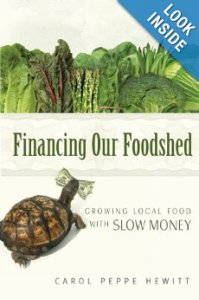The Stock Market – Explained
 Many discussions have been devoted to the question of “what is the stock market” and/ or its variant “how does it work?” Rather than rehash what others have said, I’ll attempt to reframe the question in a way that I believe is more relevant and then provide something of an answer. The purpose of the exercise being to stimulate thought and conversation, as well as to get it off my chest. I’m interested in hearing what others think on the topic, so, please add your perspective to the comments.
Many discussions have been devoted to the question of “what is the stock market” and/ or its variant “how does it work?” Rather than rehash what others have said, I’ll attempt to reframe the question in a way that I believe is more relevant and then provide something of an answer. The purpose of the exercise being to stimulate thought and conversation, as well as to get it off my chest. I’m interested in hearing what others think on the topic, so, please add your perspective to the comments.
As I examined various methods for evaluating the utility of the stock market, I wanted to address it in a way that was most relevant. Asking the right question is critical to receiving applicable information (good journalists and attorneys are adept at this skill) and it struck me that while exploring the mechanisms of the stock market might be interesting, a better question might be something more direct.
Is the stock market the ideal way for most people to invest?
Admittedly, at present it’s something of a moot point in that there are very few options outside of the stock market to legally, cost effectively invest, especially retirement funds, but I believe it’s worth exploring. Sure, there are other ways of creating wealth, such as business and real estate, but in reality all are all variations on the same theme: the growth of cash flow and assets. A business sells a product or service to generate profit while real estate relies on rental and lease income. For the sake of brevity, I’ll limit this discussion to the stock market.
Interestingly, the original concept of the stock market (exchange) is that business ownership could be reliably bought and sold, without the shenanigans of auctioneers. As with many things, the original function has been fundamentally altered over time by regulation, technology, and unintended consequences. What was originally conceived as a practical way to transfer the ownership interest of business ventures has been burdened with things like derivatives, program trading, massive concentrations of capital, and onerous regulation. The result is a system where, practically speaking, all money must flow through Wall Street.
For some the “industrialization” of investing might be a beneficial thing (I’m thinking primarily of the people at Goldman Sachs and their contemporaries), but for the rest of us it’s been a different story. Diversity is almost universally accepted as a prudent investing practice by nearly everyone with an opinion on the subject and yet we are presented a homogenous pool of investment choices. I am regularly amused (dismayed?) at the investment “options” of most company retirement plans. Typically they consist of a domestic bond fund or two, a few US equity funds, and maybe if the company offering the plan is really progressive an international equity fund or something really crazy like a real estate fund. Tragically, this sort of “diversification” falls well short of the intended purpose (non correlation of returns and risk if you are curious), even for the few investors who actually utilize all the available funds (remember 2008?). It reminds me of Henry Ford’s famous quote,
Any customer can have a car painted any colour he wants so long as it is black.
This lack of genuine diversity is only one defect exposing the shortcomings of the stock market. Aside from the obvious presence of suboptimal investment returns, there are more insidious repercussions impacting the economy on both a local and national scale. As of their April 2013 report, the Bureau of Labor Statistics listed the number of unemployed at 11.7 million. If a portion of the capital locked up in the traditional stock market were made available for local investment, I wonder how many unemployed people could start productive businesses? According to Small Business Administration, small businesses (those with less than 500 employees) accounted for 64% of net new jobs, yet the 2 primary sources of financing for small businesses are owner investment and bank credit. I may be the exception, but I’m not aware of many banks lending to unemployed people…or as Bob Hope once observed,
A bank is a place that will lend you money if you can prove that you don’t need it.
 It’s been estimated that, in the last 100 years, the recirculation rate of money in America has fallen from 25-30 to less than 10. This phenomenon is present in cities and towns across the nation stripped of their “community” by globalization. The butcher, the baker, and the candlestick maker are symbolic contributors to the local ecosystem, symbiotically producing and consuming. When citizens shop at national chains, selling imported products, they (we) act like parasites, draining communities of essential financial resources.
It’s been estimated that, in the last 100 years, the recirculation rate of money in America has fallen from 25-30 to less than 10. This phenomenon is present in cities and towns across the nation stripped of their “community” by globalization. The butcher, the baker, and the candlestick maker are symbolic contributors to the local ecosystem, symbiotically producing and consuming. When citizens shop at national chains, selling imported products, they (we) act like parasites, draining communities of essential financial resources.
The solution I propose is a mechanism that would allow people to invest efficiently in businesses connected through geographic proximity or aligned values. The profit generated by these ventures, both by businesses and the investors, would then be available to recirculate throughout the community, thus strengthening the economic ecosystem by providing stable employment, additional investment opportunities, and resilience against macroeconomic problems.
What do you think?


